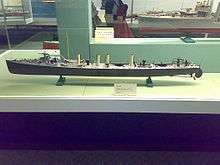Havock-class destroyer
.jpg) | |
| Class overview | |
|---|---|
| Name: | Havock class |
| Builders: | Yarrow & Company, London |
| Operators: |
|
| Preceded by: | Daring class |
| Succeeded by: | Ferret class |
| Cost: | £66,948 for 2 ships |
| Built: | 1893 |
| In commission: | 1893–1912 |
| Planned: | 2 |
| Completed: | 2 |
| Retired: | 2 |
| General characteristics [1] | |
| Type: | Torpedo boat destroyer |
| Displacement: |
|
| Length: | |
| Beam: | 18 ft 6 in (5.64 m) |
| Draught: | 7 ft 6 in (2.29 m) |
| Installed power: | c. 3,700 ihp (2,800 kW) |
| Propulsion: |
|
| Speed: | 26.78 knots (49.60 km/h; 30.82 mph) |
| Range: | 3,000 nmi (5,600 km) |
| Complement: | 46 |
| Armament: |
|
The Havock class was a class of torpedo boat destroyer (TBD) of the British Royal Navy. The two ships, Havock and Hornet, built in London in 1893 by Yarrow & Company, were the first TBDs to be completed for the Royal Navy, although the equivalent pair from J.I. Thornycroft, Daring and Decoy, were ordered five days earlier.
Background
The invention of the self-propelled torpedo by Robert Whitehead and Austrian Navy Captain Giovanni Luppis in 1866, combined with the introduction of small fast torpedo boats (invented by John Ericsson in the late 19th century) posed a threat to battleships: large numbers of torpedo boats could overwhelm a battleship's defences and sink it, or distract the battleship and make it vulnerable to opposing capital ships. Torpedo boats proved devastatingly effective in the 1891 Chilean Civil War.
The defence against torpedo boats was clear: small warships accompanying the fleet that could screen and protect it from attack by torpedo boats. Several European navies developed vessels variously known as torpedo boat "catchers", "hunters" and "destroyers", while the Royal Navy itself operated torpedo gunboats. However, the early designs lacked the range and speed to keep up with the fleet they were supposed to protect. In 1892, the Third Sea Lord, Rear Admiral Jackie Fisher ordered the development of a new type of ships equipped with the then novel water-tube boilers and quick-firing small calibre guns.
Orders
Six ships to the specifications circulated by the Admiralty were ordered initially, comprising three different designs each produced by a different shipbuilder:
- HMS Havock and HMS Hornet from Yarrows.
- HMS Daring and HMS Decoy from John I. Thornycroft & Company (the Daring class.
- HMS Ferret and HMS Lynx from Laird, Son & Company (the Ferret class).
Design

Havock was built with conventional locomotive boilers (giving her two closely spaced funnels) while Hornet was provided with 8 water tube boilers (giving her 4 widely spaced funnels). In other respects they were largely identical.[2]
These boats all featured a turtleback (i.e. rounded) forecastle that was characteristic of early British TBDs. All six of them were removed from service and disposed of by the end of 1912, and thus were not affected by the Admiralty decision in 1913 to group all the surviving 27-knot and 30-knot destroyers (which had followed on these six 26-knot vessels) into four heterogeneous classes, labelled "A", "B", "C" and "D" classes.
Construction and trials
Havock was launched first, on 12 August 1893.[1] Her sea trials on 28 October 1893 were successful, her top speed indicating that she was capable of keeping up with battleships. However, her bow torpedo tube proved to be useless as the ship would usually outrun her own torpedo. It also tended to cause the bows to dig into the sea, resulting in a very wet turtleback. As such it (and later, the turtleback) was absent in later destroyers.
Havock "behaved well" on trials. It was noted that Hornet "steers readily and well" but her coal consumption trial revealed that she used considerably more fuel than her sister.[2]
Ships
| Name | Ship Builder[1] | Laid down[1] | Launched[1] | Completed[1] | Fate[3] |
|---|---|---|---|---|---|
| Havock | Yarrow & Company | 1 July 1892 | 12 August 1893 | January 1894 | Sold 14 May 1912 |
| Hornet | Yarrow & Company | 1 July 1892 | 13 December 1893 | July 1894 | Sold 12 October 1909 |
Service
Both ships served in home waters, although Hornet was briefly in the Mediterranean in 1909.[3] Havock had her locomotive boilers replaced with water-tube boilers in 1899–1900, altering her appearance to a more standard 3-funnel arrangement.[3]
Fate
Havock and Hornet did not survive to see World War I, being broken up in 1912 and 1909 respectively.[3]
References
- Notes
- References
- Lyon, David (1996). The First Destroyers. ISBN 1-84067-364-8.
- Manning, T.D (1961). The British Destroyer. Putnam.
- Cocker, Maurice (1983). Destroyers of the Royal Navy, 1893–1981. Ian Allan. ISBN 0-7110-1075-7.
External links
| Wikimedia Commons has media related to Havock class destroyer. |